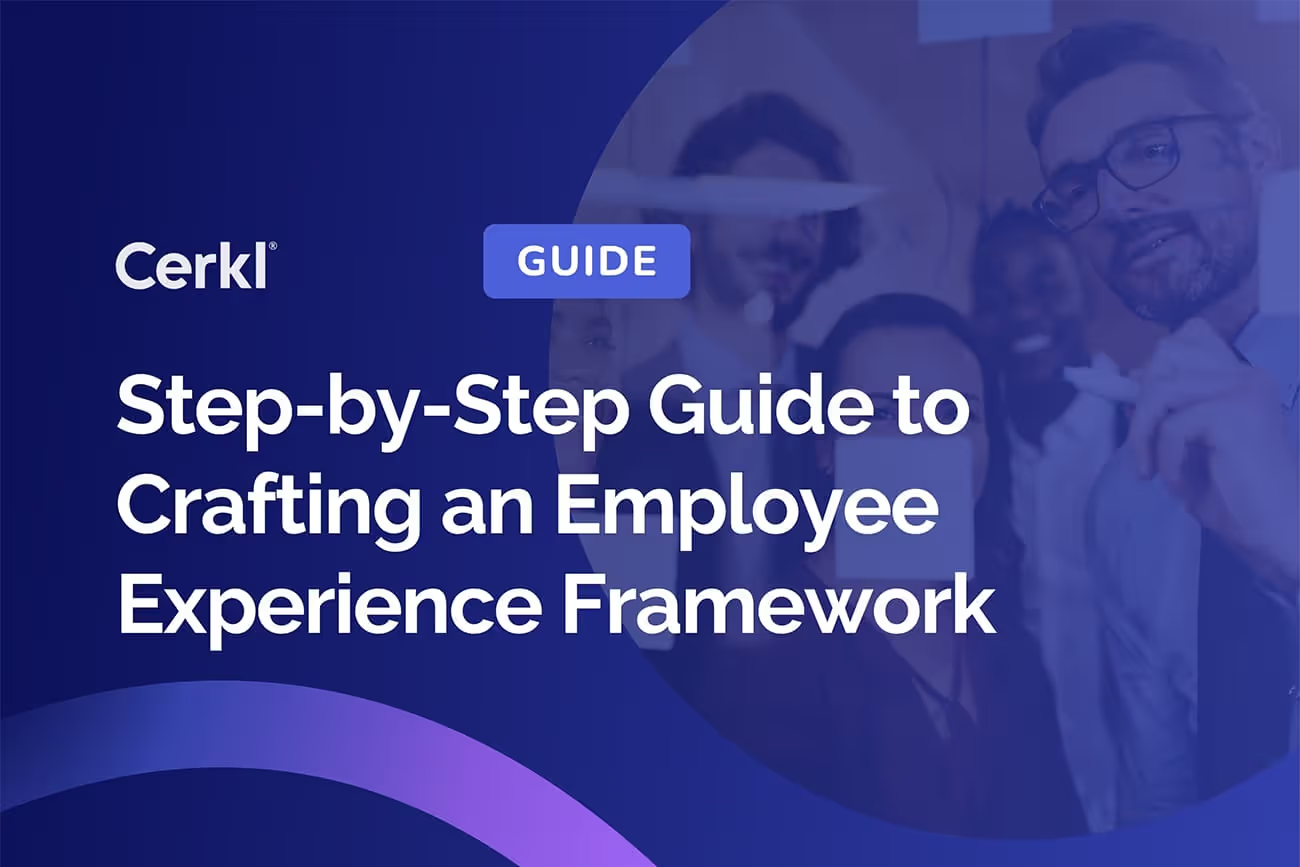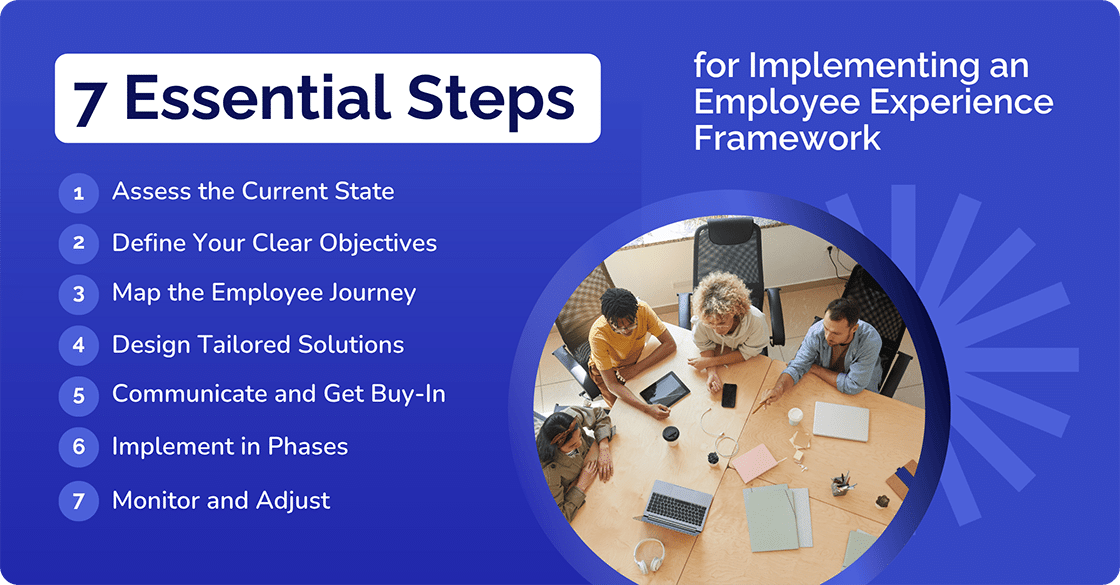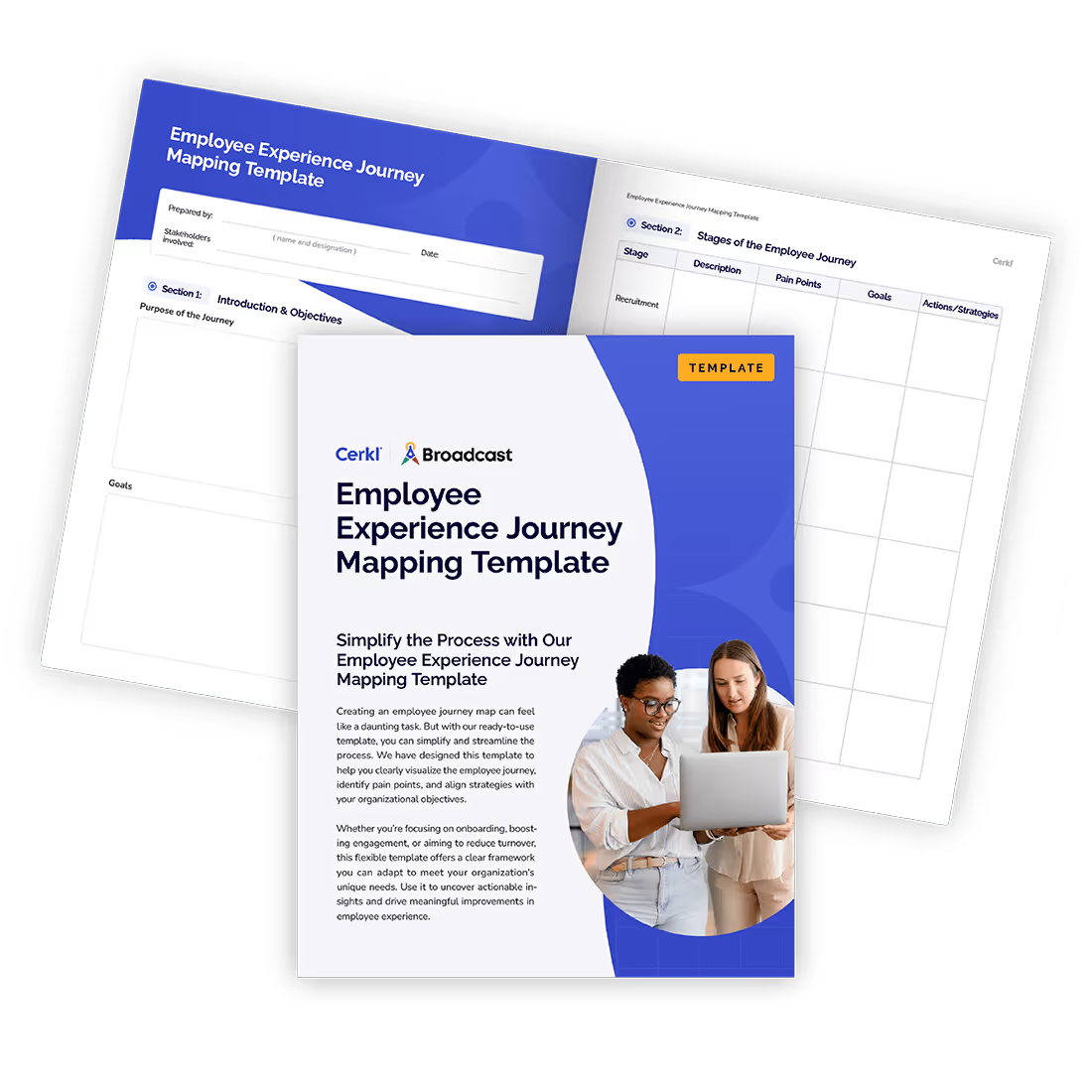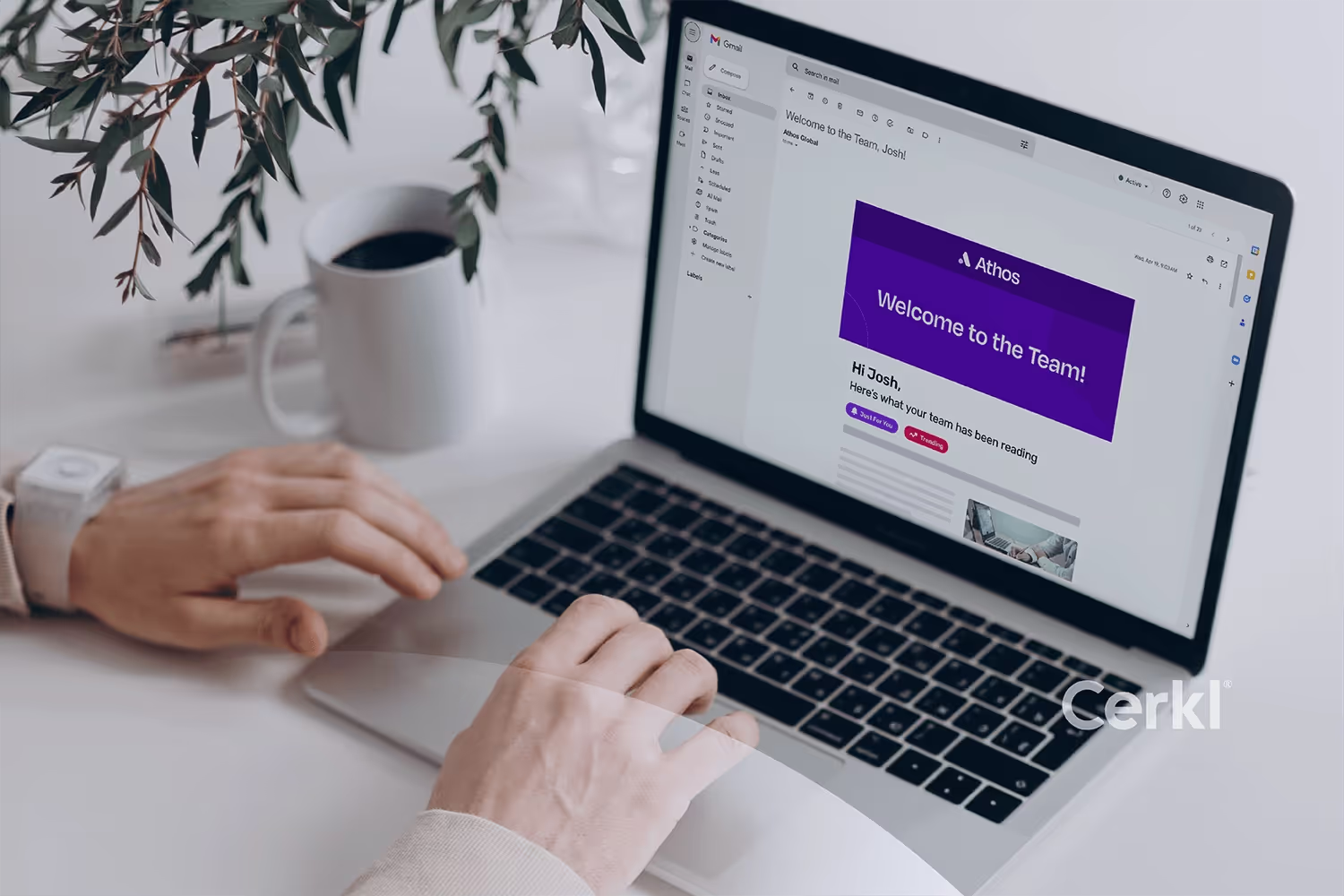Crafting an Employee Experience Framework: 7-Step Guide
Crafting an effective employee experience framework is essential for creating a positive, engaging, and productive workplace. Here’s how to do it.

.avif)
Employee Experience Journey Mapping
Start transforming your employee experience today. Download your free Employee Experience Journey Mapping Template now!
Access NowEmployee Experience Framework Fast Facts
- An employee experience framework is a structured approach that maps out key stages of the employee journey to improve satisfaction, communication, and retention. These include onboarding, growth, and exit.
- A well-designed framework helps create consistent, meaningful experiences by aligning employee needs with business goals across every stage of the journey.
- Implementing an EX framework boosts performance by enhancing productivity, reducing turnover, building a stronger workplace culture, and improving employee well-being and development.
- Organizations face common challenges such as cultural resistance, poor communication, limited resources, and difficulty measuring impact. However, these can be addressed with strong leadership and continuous feedback.
- A good communication platform like Cerkl Broadcast supports EX strategy execution by enabling targeted communication, automating personalized updates across channels, and gathering actionable feedback at each stage of the employee lifecycle.
A well-crafted employee experience framework is a strategic tool that helps organizations foster a positive and engaging work environment. As competition for top talent grows and employees’ expectations evolve, a structured approach to employee experience is crucial for attracting, retaining, and developing a thriving workforce. By focusing on key touchpoints throughout the employee journey, companies can ensure that their teams are motivated, engaged, and aligned with organizational goals.
Gallup’s State of the Global Workplace 2025 Report, the world’s largest ongoing study of employee experience (EX), provides vital global insights into the way employees feel about their work and their lives. It states that globally 40% of employees experience “a lot of stress.” However, this varies between regions. In the U.S. and Canada, for instance it is 50% of employees, putting North America at the top of the stressed out list! At only 21%, those in Post-Soviet Eurasia seem to suffer from the least stress.
Interestingly, Gallup’s State of the Global Workplace 2024 Report reported that those working in organizations with “bad management practices” are nearly 60% more likely to be stressed than those who are engaged because management practices are “good.”
However, things have improved, and the 2025 report states that companies focusing on improving best practices have experienced 22% higher engagement than those that don’t. A major problem, though, is that 44% of the world’s managers now say they haven’t received management training!

“When we consider the decline in both manager life evaluations and employee engagement, a deteriorating workplace environment is the common denominator. As with engagement, the consequences are existential for a business. Manager burnout eventually leads to declining performance, increased absenteeism and increased turnover — impacting the people they lead and the organization itself.”
Gallup 2025
What is an Employee Experience Framework?
Employee experience (EX) refers to the overall perception employees have of their journey with an organization from recruitment to exit. It encompasses every interaction, environment, and process they encounter during their employment. This includes workplace culture, career development opportunities, and day-to-day experiences. A positive employee experience enhances job satisfaction, boosts productivity, and fosters a strong sense of belonging.

An employee experience framework provides a structured approach to EX that organizations use to design, manage, and improve the employee journey. It maps out key touchpoints, such as onboarding, performance reviews, internal communications, and exit interviews, and aligns them with both employee needs and business goals to foster a supportive and engaging workplace. The framework helps ensure consistency, intentionality, and a holistic view of the employee journey.
The connection between employee experience and employee engagement is clear. As Gallup’s research indicates, when employees have positive experiences, they are more likely to be engaged, motivated, and committed to their work. By using an employee experience framework, organizations can proactively shape those experiences, making employees feel valued, supported, and connected throughout their time with the company.
Free Employee Experience Journey Mapping Template to Transform Your Workforce Engagement
Embrace journey mapping and transform employee satisfaction and engagement into a data-driven strategy.

Download Free
Importance of an Employee Experience Framework
An employee experience framework is essential because it provides a structured approach to enhancing all aspects of an employee’s journey within an organization, from recruitment to exit. Here are 10 reasons why the framework plays a vital role.
#1 Boosts Employee Engagement
A positive EX fosters higher levels of engagement, making employees more invested in their work. According to Gallup companies with highly engaged employees have 23% higher profitability compared with those with low engagement levels. This is because they are more motivated and aligned with company goals.
#2 Enhances Productivity and Performance
Engaged employees are not only happier but also more productive, driving the overall success of the organization. When employees feel supported, they perform better and contribute to the business’s growth.
Gallup’s 2025 report also states that highly engaged employees achieve 14%-18% higher productivity, depending on their roles.
#3 Attracts and Retains Top Talent
A strong employee experience framework helps attract top-tier talent and reduce turnover. Employees are more likely to stay with an organization that values their well-being and personal growth.
When it comes to low-turnover organizations, Gallup found that turnover was reduced by 51% and 21% for high-turnover organizations.
#4 Builds a Positive Workplace Culture
A well-structured EX framework fosters a culture of trust, support, and community where employees feel valued. This enhances collaboration and mutual respect, which are the cornerstones of a thriving workplace culture.
#5 Sparks Innovation and Creativity
By creating an environment where employees feel safe to share ideas and take risks, organizations can encourage greater innovation and creativity. This drives business growth and keeps the company competitive in its industry.
#6 Prioritizes Employee Development
Employee experience frameworks emphasize continuous learning and development, providing opportunities for skill-building and career progression. This motivates employees to stay and grow with the company, benefiting both parties.
#7 Facilitates Continuous Feedback and Improvement
Regular feedback is key to improving the employee experience. Studies show that employees who receive meaningful feedback are significantly more engaged, driving overall organizational success. More specifically, Gallup’s 2024 Employee Engagement Strategies Checklist indicates that 80% of employees who said they received meaningful feedback in the week prior to the survey were fully engaged. It didn’t matter how many days they had worked in the office.
#8 Strengthens Brand Reputation
A positive employee experience not only enhances internal satisfaction but also builds a strong employer brand. Satisfied employees become brand ambassadors, boosting the organization’s reputation among potential hires and customers.
#9 Ensures Compliance and Reduces Risk
A well-defined employee experience framework helps ensure compliance with labor regulations and mitigates risks related to employee dissatisfaction, thus protecting the company from potential legal or ethical issues.
#10 Drives Bottom-Line Impact
Ultimately, a great employee experience contributes to higher organizational performance, reduced turnover, and increased customer satisfaction. Engaged employees provide better service, which boosts customer loyalty and revenue.

Common Challenges of Implementing an Employee Experience Framework
Implementing an employee experience framework is not without challenges. Addressing these challenges requires proactive leadership, clear communication, and a focus on aligning the framework with both employee needs and business goals.
Cultural Resistance
One of the biggest hurdles is resistance to change, particularly from leadership or employees who are accustomed to existing processes. Aligning the EX framework with the company’s culture and securing buy-in from all levels of the organization can be difficult.
Lack of Leadership Engagement
If leadership doesn’t actively support and participate in the implementation, it can be difficult to get full organizational alignment. Leaders play a crucial role in setting the tone for employee experience, and their involvement is essential for success.
Inconsistent Communication
Poor communication during implementation can lead to misunderstandings or employee disengagement. It’s critical to ensure clear, consistent messaging so that all employees understand the framework goals and their role in it.
Resource Constraints
Designing and rolling out a comprehensive employee experience framework requires time, budget, and personnel. Smaller organizations or those with limited resources may struggle to allocate the necessary investments to build and sustain the framework.
Measuring Success
Establishing the right metrics to track the success of a framework can be challenging. It’s important to gather both qualitative and quantitative data to continuously improve the framework, but many organizations find this difficult to manage.
Sustaining Momentum
Keeping the initiative alive and relevant over time requires ongoing commitment. Continuous improvement and regular updates to the framework are necessary to address evolving employee needs and organizational changes.
Free Employee Experience Journey Mapping Template to Transform Your Workforce Engagement
Embrace journey mapping and transform employee satisfaction and engagement into a data-driven strategy.

Download Free
7 Essential Steps for Implementing an Employee Experience Framework
By following these seven steps, organizations can create a comprehensive, adaptable employee experience framework that enhances both employee satisfaction and business outcomes. Here’s your 7-step roadmap.
Step 1: Assess the Current State
Begin by evaluating your existing employee experience. Collect data through surveys, interviews, and focus groups to understand pain points, needs, and expectations across various employee touchpoints such as onboarding, development, and exit processes. Analyze data from exit interviews, performance reviews, and employee engagement surveys to get a comprehensive view. This assessment will help you identify strengths and areas for improvement, providing a solid foundation for your framework.
Step 2: Define Your Clear Objectives
Based on the assessment, set specific goals for your employee experience framework. These objectives should align with your company’s mission and strategic priorities. Your goals might include improving employees’ engagement, reducing turnover, enhancing productivity, or fostering a more inclusive culture. Make sure they are SMART (Specific, Measurable, Achievable, Relevant, and Time-bound) to guide your efforts and track progress.
Step 3: Map the Employee Journey
Identify and document critical touchpoints in the employee journey, from recruitment to exit, and create a detailed map. This should include key moments like onboarding, promotions, career development, performance evaluations, and professional transitions. Understanding these touchpoints will help you focus efforts on areas with the highest impact.
Be sure to consider factors including career development, performance management, recognition, and work-life balance. Mapping the journey will help you understand the current state and design interventions that improve the experience at critical points.
Step 4: Design Tailored Solutions
Based on your assessment and goals, design a framework that addresses the identified pain points and enhances positive touchpoints. Create initiatives that address the specific challenges and opportunities at each touchpoint. Customize your framework for different employee personas or groups to ensure that it resonates with diverse workforce needs. Be sure to use employee personas and journey maps to create tailored experiences that resonate with diverse groups within your organization.
Step 5: Communicate and Get Buy-In
Share the framework with key stakeholders, including leadership, managers, and employees. Effective communication is vital to ensure understanding and buy-in at all levels. Use various channels such as meetings, emails, or presentations to socialize the new framework. Communication is key to getting buy-in and ensuring everyone is aligned with the goals and processes of the framework.
Step 6: Implement in Phases
Start by piloting the framework with a specific group or touchpoint to test its effectiveness. Gradually roll it out across the organization, making adjustments as necessary based on feedback and results from the pilot.
Step 7: Monitor and Adjust
Continuously gather feedback and track metrics such as employee engagement, retention, and productivity. Regularly assess the performance of your framework and make improvements to address changing employee needs and organizational dynamics. It’s vital to foster a culture of continuous improvement to keep the employee experience dynamic and responsive. Encourage employees to share their experiences and suggestions for improvement. Use data analytics to monitor the effectiveness of the framework and make data-driven decisions.

Celebrate successes and learn from challenges to keep the momentum going.
How to Measure the ROI of an Employee Experience Framework
To accurately measure the return on investment (ROI) of an employee experience framework, organizations need to focus on both qualitative and quantitative data. Key metrics include employee engagement and satisfaction scores, such as pulse surveys and eNPS, which provide direct feedback on how employees feel about their experience. Improvements in these scores can be linked to better productivity and overall organizational health.
Additionally, it is critical to track employee retention and turnover rates. Reductions in turnover result in significant cost savings related to recruitment, onboarding, and training, which contribute positively to ROI. Improved productivity metrics, including higher task completion rates and lower absenteeism, are also important indicators of a successful employee experience framework.
Companies can measure customer satisfaction and revenue growth as indirect indicators of EX success. Happier, more engaged employees often deliver better customer service, leading to increased customer loyalty and higher revenues. Combined, these factors show how a well-implemented EX framework positively impacts both the employee experience and the organization’s bottom line.
How Can Cerkl Broadcast Help You Implement Your Employee Experience Framework?
Implementing an effective employee experience framework requires a multifaceted approach that integrates communication, engagement, and continuous feedback. The Cerkl Broadcast platform can play a pivotal role in this process.
For example, using Email Blasts and News Digests, organizations can effectively communicate their goals and values, ensuring the vision for the employee experience framework is clearly conveyed to employees. This targeted approach allows for segmented communications tailored to different stages of the employee preferences and lifecycle. It enables communicators to address each touchpoint from onboarding to career development with relevant and timely information.
Cerkl Broadcast’s centralized communication hub integrates various methods, ensuring all employees receive important updates and information seamlessly. Its omnichannel capabilities allow employees, whether remote, on-site, or hybrid, to access messages conveniently, while scheduling features enable strategic planning of message timing and frequency.
Moreover, Cerkl Broadcast is excellent for collecting feedback, which is crucial for continuous improvement and employee satisfaction. The platform offers multiple ways to invite and manage feedback, aligning with what employees need and want from their communication tools.
What’s Next?
A well-crafted employee experience framework is a strategic tool that helps organizations foster a positive and engaging work environment. As competition for top talent grows and employees’ expectations evolve, a structured approach to employee experience is crucial for attracting, retaining, and developing a thriving workforce.
Do you think Broadcast can help you with your EX framework?
If you’re unsure, we urge you to use our free employee experience journey mapping template. It will help you to clarify key pain points and opportunities, and visualize the employee lifecycle, enabling you to set clear, measurable goals to improve communication, solve challenges, and boost loyalty.
Then if you’d like to know more about the platform, you can contact us. We’d love to chat!

Free Employee Experience Journey Mapping Template to Transform Your Workforce Engagement
Embrace journey mapping and transform employee satisfaction and engagement into a data-driven strategy.
Download Free
FAQ
What is an employee experience framework? An EX framework is a structured approach to understanding and improving all the touchpoints and interactions employees have throughout their lifecycle in an organization. It helps align employee needs with company goals to enhance satisfaction, productivity, and retention.
How can you design an employee experience framework? To design an EX framework, first gather insights through employee feedback, surveys, and data to understand pain points and needs. Then, map out the key stages of the employee journey (from recruitment to exit) and implement an employee experience strategy that will improve communication, culture, and support systems at each stage.
What are the key components of employee experience? The key components of employee experience include workplace culture, physical and digital work environment, employee well-being, professional growth and development opportunities, and leadership/management communication. Together, these elements shape how employees feel about their work and influence EX and retention.
What does employee experience management entail? It entails actively monitoring, analyzing, and improving all aspects of an employee’s journey within the organization from recruitment to exit. It involves using data, feedback, and insights to enhance EX, satisfaction, and overall performance, ensuring a positive and productive work environment.









